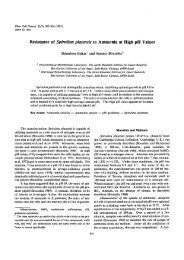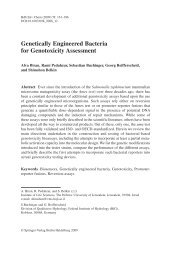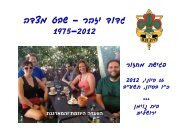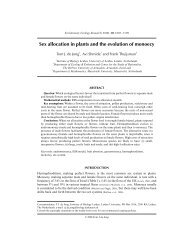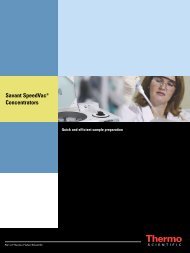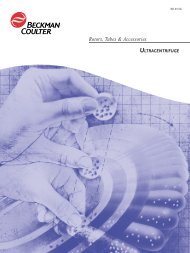LIQUID SCINTILLATION COUNTING
LIQUID SCINTILLATION COUNTING
LIQUID SCINTILLATION COUNTING
Create successful ePaper yourself
Turn your PDF publications into a flip-book with our unique Google optimized e-Paper software.
Optical<br />
Quenching<br />
PMT<br />
Phosphor<br />
Photoluminescence<br />
Pulse<br />
Quenching<br />
QIP<br />
Secondary<br />
Scintillator<br />
Solvent<br />
A reduction in the scintillation intensity seen by the photomultiplier tubes<br />
due to absorption of the scintillation light either by materials present in<br />
scintillation solution or deposited on the particle energy and usually a<br />
reduction in counting efficiency.<br />
The Photo-Multiplier Tube is an electron tube that detects the blue light<br />
flashes from the fluor and converts them into an electrical pulse.<br />
A luminescent substance or material capable of emitting light when<br />
stimulated by radiation.<br />
Delayed and persistent emission of single photons of light following<br />
activation by radiation such as ultraviolet.<br />
Electrical signal of the PMT; its size is proportional to the radiation energy<br />
absorbed by the cocktail.<br />
Anything which interferes with the conversion of decay energy emitted<br />
from the sample vial into blue light photons. This usually results in<br />
reduction in counting efficiency.<br />
The Quenching Index Parameter is a value that indicates the sample's level<br />
of quenching. Another parameter that describes the amount of quenching<br />
present is the transformed Spectral Index of External Standard (tSIE) or<br />
"H" number.<br />
Material in the scintillation cocktail which absorbs the emitted light of the<br />
primary scintillator and remits it at a longer wavelength, nearer the<br />
maximum spectral sensitivity of the photomultiplier tubes. It is added to<br />
improve the counting efficiency of the sample.<br />
A chemical component of the liquid scintillation cocktail that dissolves the<br />
sample, absorbs excitation energy and emits UV light which is absorbed by<br />
the fluors.<br />
LSC EXTERNAL SETTINGS<br />
LSC’s come in a variety of shapes and types and manufacturers may use different terminology,<br />
however, the following basic external controls are commonly found on most systems.<br />
Gain<br />
A control used to adjust the height of the signal received by the detecting system.<br />
The gain control for newer LSC’s is often automatically set for the particular<br />
radionuclide selected.<br />
4




